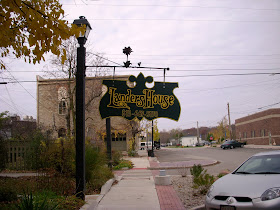Scott and I celebrated our 7 year anniversary last weekend by making our annual 3 day trip to an area with parks, hiking and a bed and breakfast. This year we went to Utica, Illinois. Utica is unique because it is a small town but if offers 3 state parks all within an 8 mile radius of each other. We got to Utica on Friday afternoon and after a quick lunch and check-in we went to Starved Rock State Park.

The quality of the above picture is not great but any time you start out on a trail and get to the first overview and see a bald eagle you have to post it. You don't have to be a birder to appreciate how amazing the bald eagle is. One of the coolest birds our area has to offer. Starved Rock has a pair of eagles that winter and nest in the park.

Starved Rock was beautiful. As you can see the park is made up of many (18 to be exact) canyons. There are trails that allow you to hike into the canyons and get great views of the waterfalls and tree covered sandstone bluffs.

We were a little late in the year to see the peak of fall colors but the trees still had quite a few leaves and the rain held off all weekend so it made for great views, hiking and birding.

We wish we would have had more time to spend at Starved Rock. We only walked about 4 of the 13 miles of trails that the park has to offer. I heard the park is especially beautiful during wildflower season. We hope to return and take in some wildflowers and hike more of the trails.

Saturday we went to Matthiessen State Park. Matthiessen is also a park that is full of canyons and streams. It did not take long for us to realize that the recent rains had caused the streams to flood. Scott and I didn't care. We decided to "take the plunge" anyways and follow the trails as best we could.

Many bridges led us through the canyons and dells. It was also crazy to see how these relatively large trees could root and prosper in an area that was pretty much stone. As you can see from the below picture the trees have very little dirt to root in.

The next picture is just comical because you can see the trail (wooden boardwalk) that is completely under water. Scott was not up for a swim so we found a new way around that part of the trail.

In addition to our hiking we also enjoyed a couple of nights out with good food and good company. Although I don't have an pictures, I have to give a shout out to Cajun Ron from the Cajun Connection. Great restaurant with authentic Cajun cuisine. The atmosphere was fun and Cajun Ron even chatted with us and gave us complimentary pecan pie for our anniversary. Some of the best food I have ever eaten. The second night we ate at a local steakhouse restaurant and then enjoyed a couple of drinks while taking in some football and the World Series.

As you can see, Scott upheld tradition and upon arriving at the bed and breakfast there were 7 red roses (1 rose for each year we've been married) waiting for me.

Long story about the bed and breakfast but to summarize we have renamed it the "bed-n" because we never got breakfast and the above picture is us locked out of the bed and breakfast on Sunday morning.

We would not recommend the Lander's House to anyone in the Utica area but we did have a wonderful time in the area. Utica is a great town with lots to do for the nature lover. Thanks Scott for a fun and memorable anniversary. You make "til death do us part" seem too short.
























